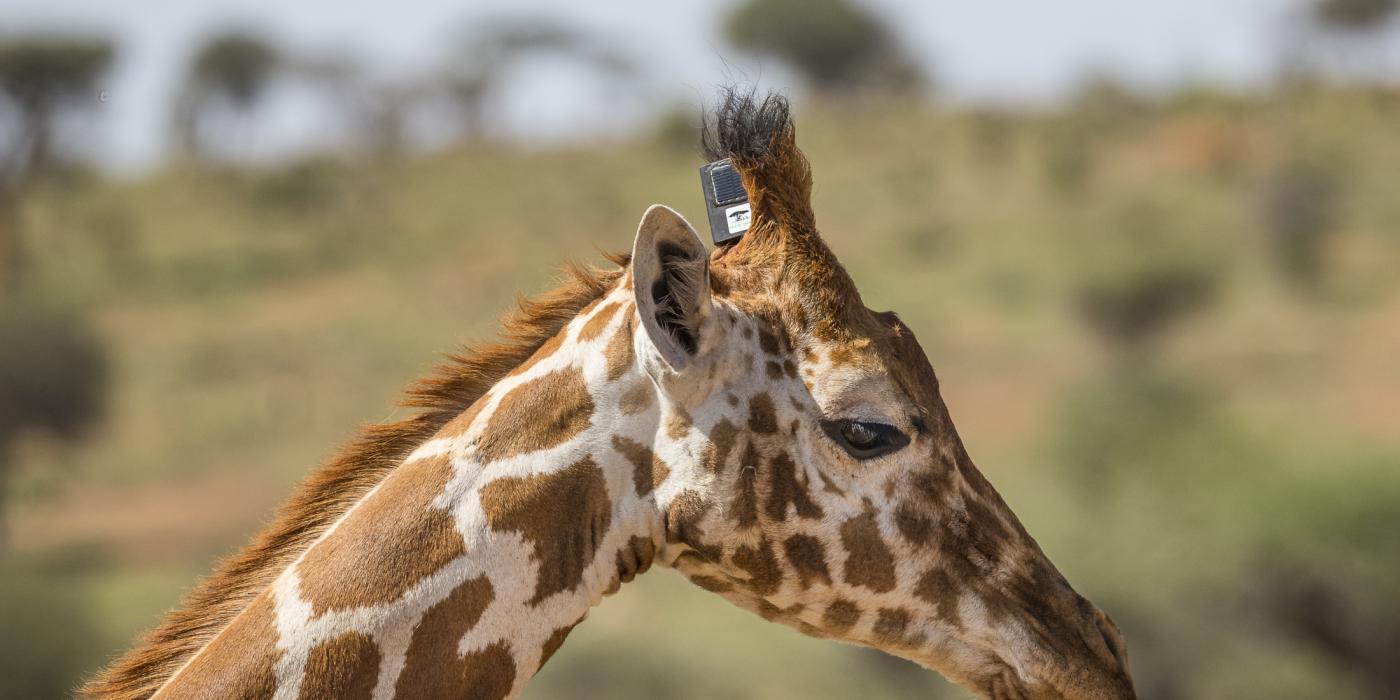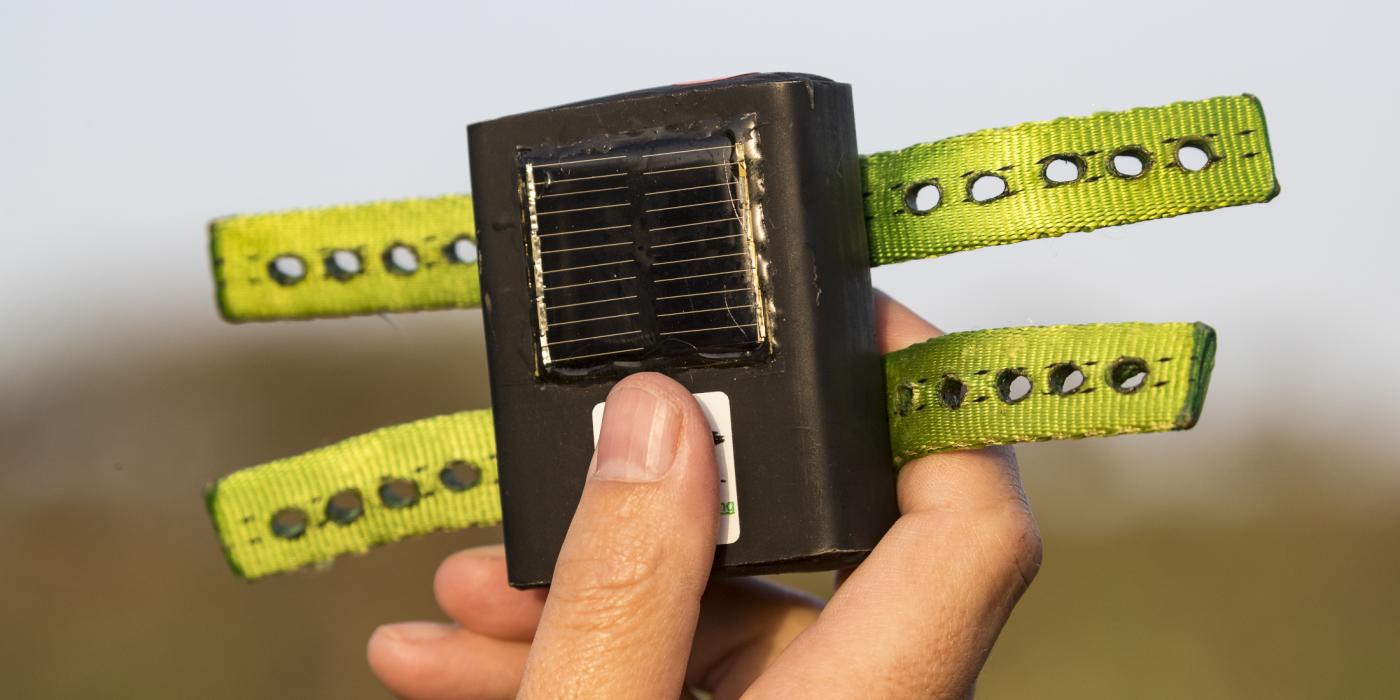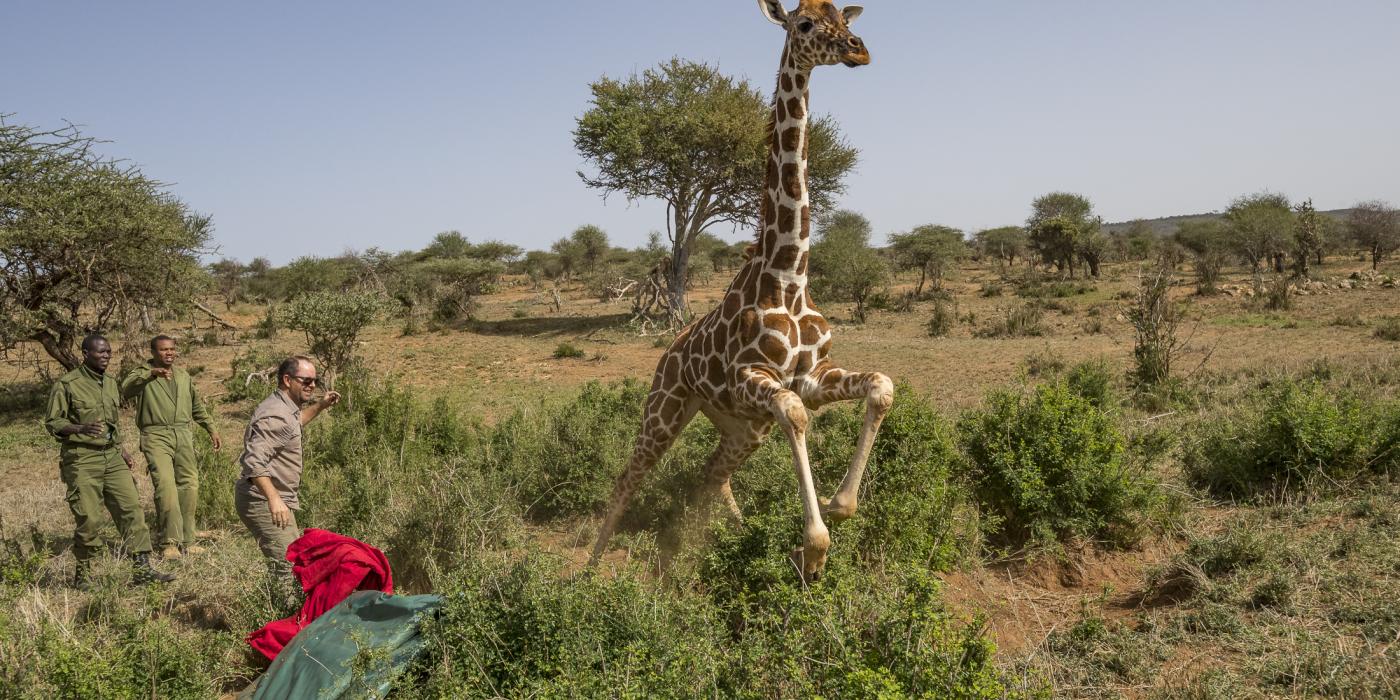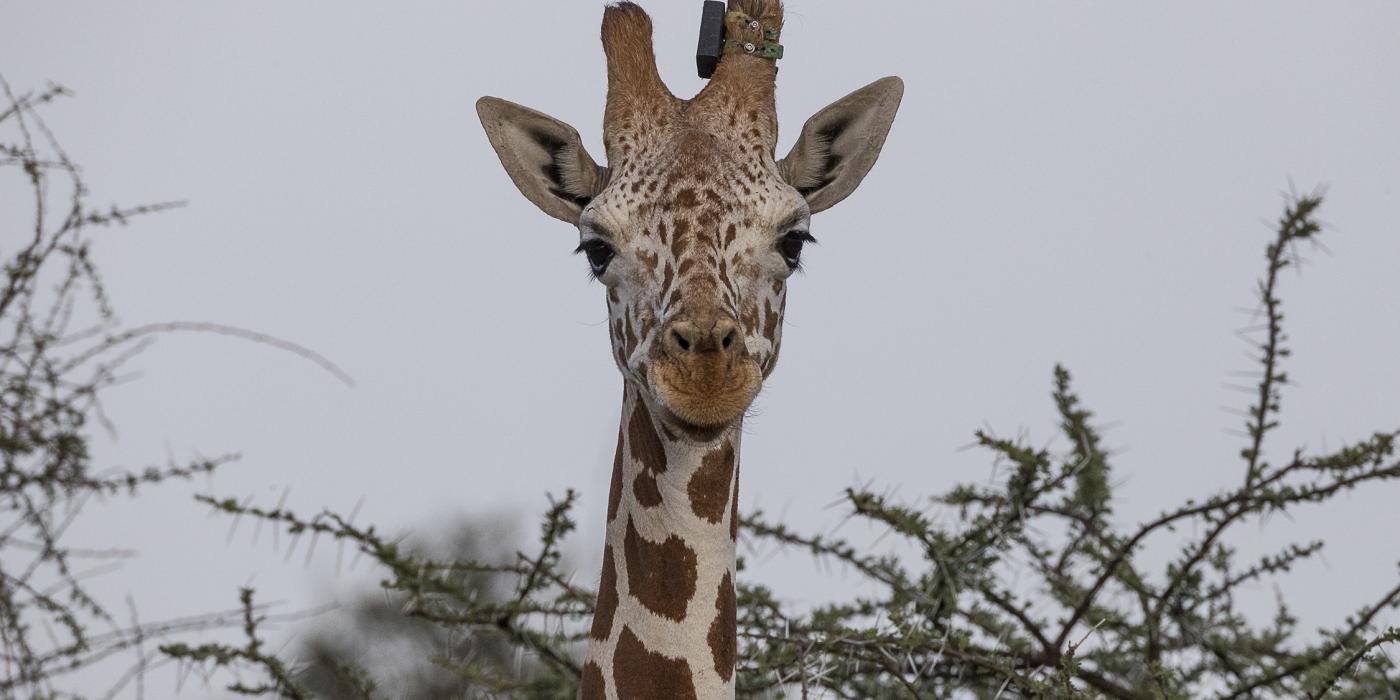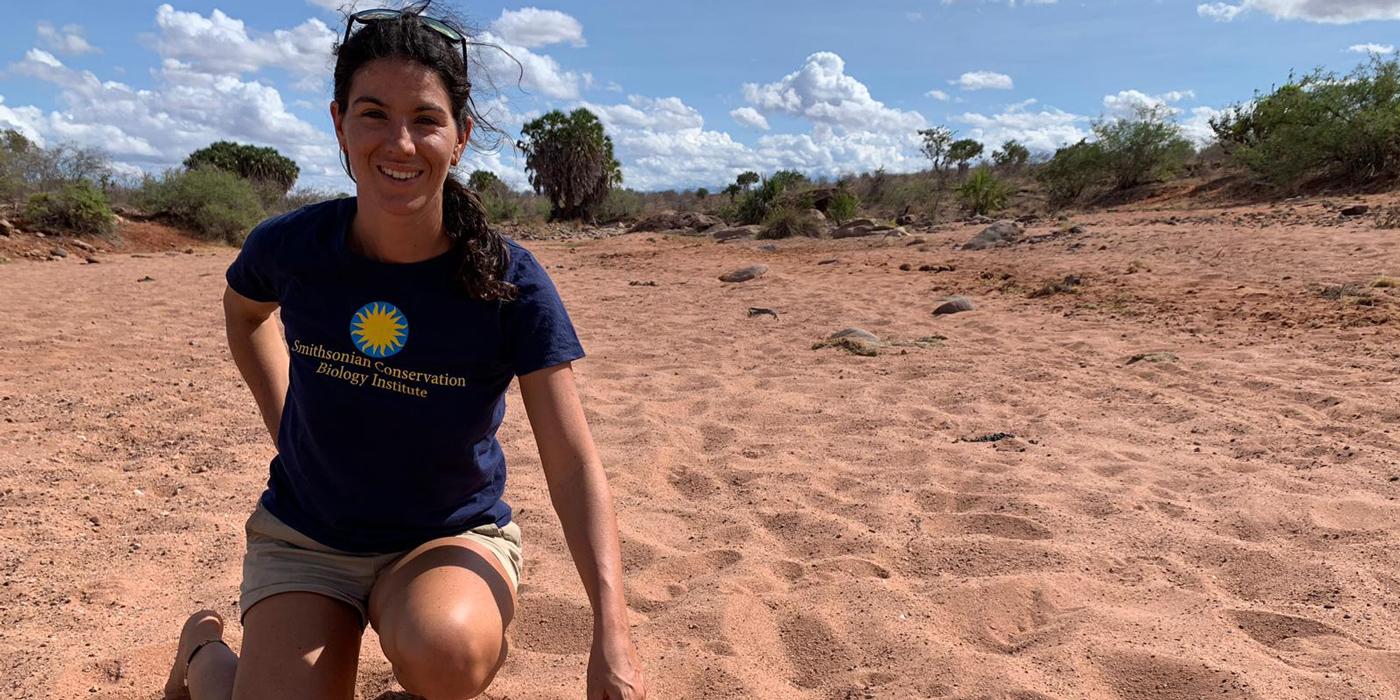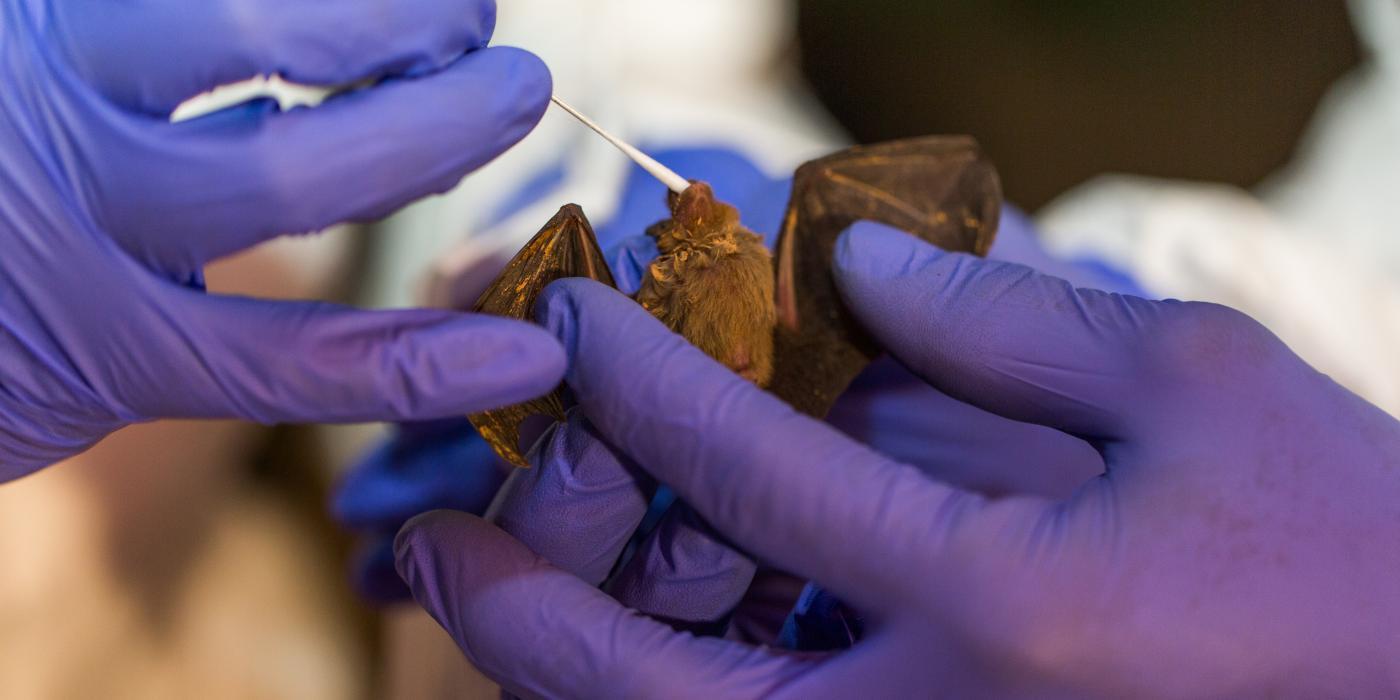Newly Collared Giraffes in Kenya Could Pave Path for Species Conservation
Despite their ever-so-long necks, giraffes have historically not made for good candidates for GPS tracking. Instead, those long necks have been part of the problem—when the animals lean down for a drink, the GPS collars that sit so gently around the necks of other species, slide right off. So Smithsonian Conservation Biology Institute (SCBI) scientists and partners are trying a new design. In June, they secured GPS collars around the ossicones, the horn-like structures atop their heads, of 11 reticulated giraffe in Kenya, which are now sending back hourly GPS locations via satellite to the researchers daily. With support from donors, Friends of the National Zoo's Conservation Nation program is funding the purchase of giraffe trackers.
The study, which brings together SCBI’s Conservation Ecology Center, Smithsonian’s Global Health Program, Kenya Wildlife Services, Giraffe Conservation Foundation, Northern Rangelands Turst, The Nature Conservancy, Loisaba Conservancy, Lewa Wildlife Conservancy, Senckenberg BiK-F and San Diego Zoo Global, will help answer questions researchers have never been able to properly answer before. How far do the animals move? Where do the animals regularly go? What type of habitat do they depend on in different seasons? What are the biggest threats to their survival? What is the cause of the newly emerging disease, giraffe skin disease? How does it spread? How does the skin of an infected giraffe compare to that of a non-infected giraffe? And how might this disease interact with other threats, such as habitat loss, climate change and localized poaching?
Ultimately, the interdisciplinary work could help conservationists better understand why giraffes are in rapid decline and how best to save them from extinction, say David O’Connor, who works closely with SCBI’s Conservation Ecology Center in his role at the San Diego Zoo Global; and Suzan Murray, program director of the Smithsonian’s Global Health Program.
What are the primary questions your team wants to answer about giraffe movement through this study?
David: We really know very little when it comes to giraffe ecology. At its most basic level what we’re trying to understand the scale of giraffe movements, what are their home range sizes in northern Kenya and whether they engage in any movements on a big scale. This way we can better understand whether coming changes to the environment may block some of their movement routes. We’re also really interested in understanding whether giraffe habitat differs during the dry season and the wet season, so we can best protect it.
Why has this information been so difficult to get in the past?
David: Giraffe have been rather understudied compared to how famous they are in the public eye. People just really haven’t paid much attention to them. That’s changed in the last 10 years or so, but until then it was less than a handful of researchers who did work with giraffe.
It has also been challenging to safely collar giraffe and to do so effectively. You can’t do what we think of as a normal collar that you put around animals’ necks because when giraffes put their heads down to drink, it slips off. Researchers have tried units that are like dog harnesses, and others that are head units. But those led to restrictions on movements or on eating, so those units were removed. Just this year a company in Kenya developed a new design for a collar that goes on the giraffe ossicones. It’s solar powered and small and we’ve seen nothing behaviorally or in terms of the animals health so far that indicates these are bothering the animals.
How do you collar a giraffe?
David: On this study we worked very closely with the Kenya Wildlife Service, whose experienced vets took the lead on sedating and handling the animals. We dart the animals with an immobilization drug, then hang back and wait until it looks like the drug is taking effect. When we know it’s ready to fall, the capture team of four or five people goes in with ropes to put around the animal’s legs to help it safely lie down on the ground. We then give the animal oxygen and take bio-measurements and blood, hair and skin samples while the units are attached to an ossicone. It usually takes about 10 minutes. It was quite amazing to watch the giraffes get up and walk or run perfectly well afterward.
What is it like to be that close to giraffe in the wild?
David: It’s pretty amazing. We sometimes see them in collections at zoos or maybe on safari in a vehicle, but when you’re on foot on the ground, they’re so much bigger. And when they’re running at you at full tilt, they’re much bigger. What surprised me was how tough they are. We sometimes think of giraffe being these dignified, dainty animals, but they are really tough. It’s just magical to be that close to them. They’re so, so unique.
How do you hope the data that you collect will help conserve giraffes?
David: There are a couple of ways that I hope this will happen in Northern Keyna, where there’s a landscape of coexistence between people, livestock and wildlife. Some organizations are creating community conservancies who manage their land for a sustainable coexistence of wildlife, livestock and people. I hope we will be able to show the importance of these conservancies for giraffe and other wildlife, compared to degraded land. That will show the community conservancies how valuable their work is and will help us prioritize our conservation efforts going forward.
Giraffe movements also give us vital information about the spaces and habitat types giraffe use, and need to survive during both the dry season and wet seasons in northern Kenya, and how they move between these places.
We can prioritize scarce conservation resources to protect those areas. We can also try to inform incoming infrastructure developments, be it the building of highways, pipelines, railroads or more human settlement. Maybe we need to alter the placement of particular development projects for giraffe to be able to move. We’ll have this information on hand when the government asks what it can do for the animals in the course of these projects.
What are you trying to better understand about giraffe skin disease through this collaring work?
Suzan: We’re trying to develop a database so we can understand normal values in giraffe, but also the causes and agents of giraffe skin disease and how the giraffe’s pattern of movement and overlap with other species may or may not contribute go the development of this illness. In the case of these giraffes, we were able to get skin biopsies from healthy animals—normal giraffes—so we can compare the skin samples to those from giraffes with this skin disease.
When we have a better understanding of the factors that affect an animal’s survival, we can make recommendations to help mitigate some of the risks.
Are you worried that giraffe skin disease will affect giraffes in Kenya?
Suzan: So far it has been documented in Tanzania and Uganda. It has not been documented in Kenya yet, although we suspect that it will make its way there soon, if it’s not there already. In preparation for this, we’re enhancing veterinary capacity with Kenya Wildlife Services to do these kinds of health studies.
What are the benefits to doing these kinds of cross-disciplinary studies?
Suzan: The Smithsonian and our partners has so many different areas of expertise, and the more that we can work together and support each other’s research, the better. In this case, I’ll learn more about where the individual animals are going and SCBI’s Conservation Ecology Center will learn more about the animals’ health status. With this information, together we can help advise on how to help prevent these animals from going extinct.
Is this the extent of SCBI’s focus in Kenya?
Suzan: Collectively, we have several conservation projects in Kenya. We’ve had a long-standing relationship with Kenya Wildlife Services and work hand-in-hand with the Impala Research Center on nearly everything we do in Kenya. The Smithsonian Conservation Biology Institute is really taking a strong lead and utilizing our existing expertise and partnerships. We have a wealth of knowledge and expertise at SCBI.
The Global Health Program is doing this kind of work all over the world. We have all of this great information at the Smithsonian’s National Zoo, where the animals receive top-tier health care. This is our opportunity to take that internationally. So we’re working with pandas in China; rhino, giraffe, kori bustards and lions in Kenya; cheetahs in Namibia; bats and elephants in Myanmar. This is really an example of the Smithsonian at its finest.
This story appears in the July 2017 issue of Smithsonian Conservation Biology Institute News. Click here for information on how to support SCBI's efforts to track giraffes through Friends of that National Zoo's Conservation Nation program.
